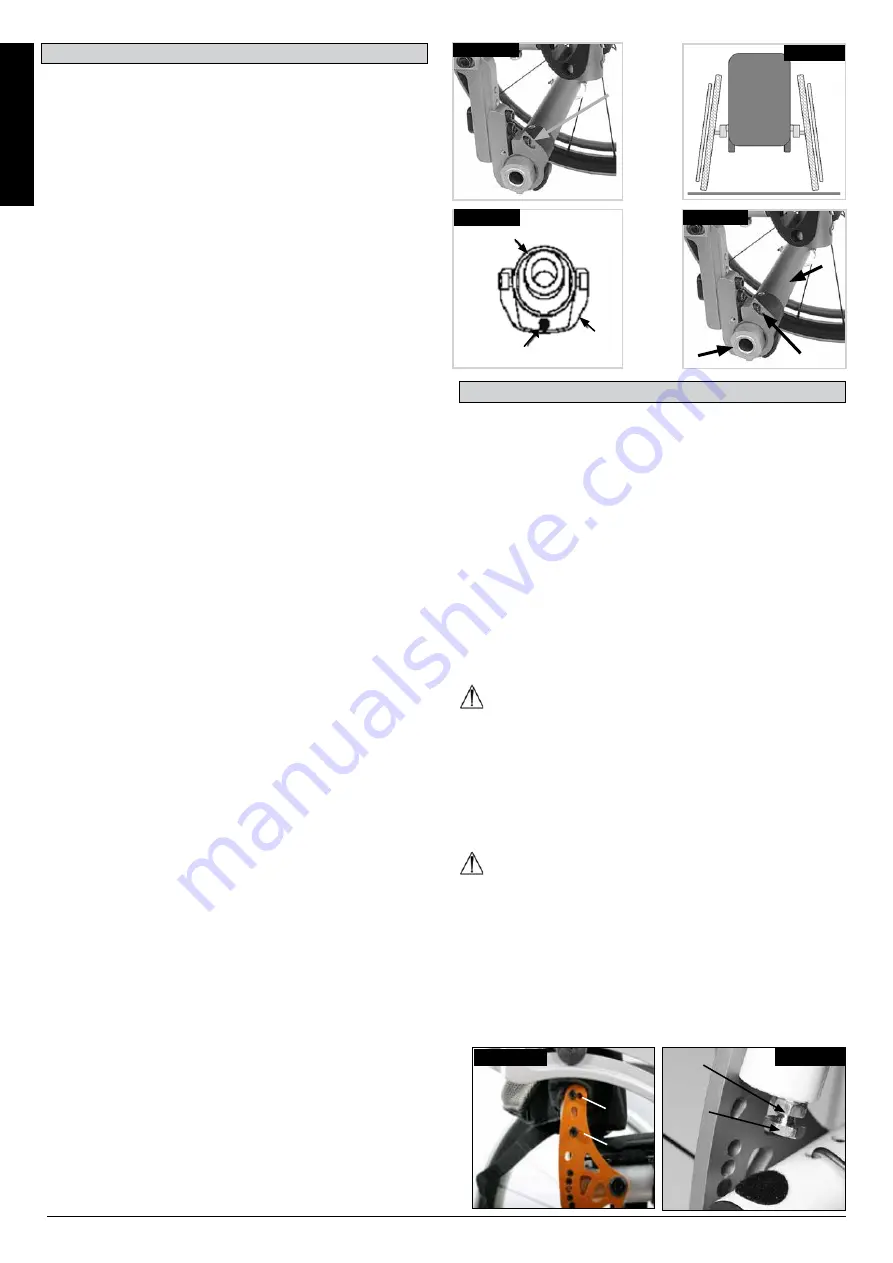
38
ENGLISH
Argon
2
Rev.C
Wheel alignment
Adjusting The Wheel Alignment
Important:
To achieve the very best movement, the rear
wheels must be adjusted to their optimum position, which
means correctly adjusting the wheel alignment.
To do this, measure the distance between both wheels
front and rear to ensure that they are parallel to one
another.
The difference between both measurements should not
exceed 5 mm.
To adjust the wheels to make them parallel, loosen the
screws and turn the axle sleeve accordingly. Make sure
that after any adjustment work, all screws are tightened
correctly (see the page on torque).
Argon2 Tracking Adjustment
Setting the toe-in/toe-out to zero.
NOTE:
A wheelchair with 0° camber cylinders cannot
have toe-in or toe-out. This setting is necessary only with
3°, 6
°
and 9° camber cylinders.
The term "toe-in or toe-out" defines how well the rear
wheels of the chair are aligned in relation to the ground.
This determines how well the chair will run. Normal
resistance or rolling resistance is present when toe-in is
set to zero.
To set toe-in/toe-out to zero: loosen the Allen screws (1)
(1 on each side), which secure the angle tube clamp.
Check the ball in the horizontal (2) plane and turn the
angle tube (3) until the ball is in the centre. Toe-in is now
zero.
Before tightening the screws (1), check that the camber
tube is centred left-to-right. The gap should be the same
on both sides, or there should be no gap at all. Tighten the
screws to 7 Nm. (Fig. 4.21-4.23).
Adjusting the Rear Wheelbase Width:
The rear wheelbase is defined as the distance between
the upper side of the rear wheels and the backrest tubes,
and is represented by factory setting (1.25 cm). This has
to be increased if a larger gap between the tyres and the
optional height-adjustable armrests has to be created
(Fig. 4.24).
NOTE:
When adjusting the rear wheelbase, adjust first
one wheel then the other. If both sides are loosened at the
same time, this will alter the toe-in/toe-out adjustment. To
adjust the rear wheelbase, the parts of the camber (4)
move telescopically into or out of the camber tube (5), and
lock into place when they reach the end. Loosen screw (6)
(located closest to the camber tube) on the left side of the
chair. Move the quick-release axle inwards or outwards to
achieve the desired wheelbase. Tighten the screws to 7
Nm. Repeat this procedure on the right side of the chair
and adjust the gap so that it is the same amount as on the
left side.
Fig. 4.23
BALL
3
2
Angle-Adjustable Back
The backrest angle is adjusted by altering the position of
the pin in the backrest mounting. The pin (1) must be
completely clicked into place in the hole pattern on both
sides, this gives you an angle adjustment of 8.5°.
Fit the red plastic pins into the unused holes. To reach a
smaller angle increment (3.5°), you open the allen key
screw (2) and re-set the screw into the second hole.
Please use the relevant torque force (see matrix) to
tighten the screw (2).
This gives you 12° change in the back angle. Then move
the pin (1) in the opposite direction to the next hole, which
gives you 12° - 8°= 3.5° change. (Fig. 4.25)
To reduce the play in the backrest, the nut (1) can be
released, then the optimal position can be set using the
set screw (2). Then re-tighten the nut (1). (Fig. 4.26).
CAUTION !
The screws must be re-tightened. Otherwise the angle
adjustment will be lost.
Folding Backrest
Release the backrest by pulling the cord. At the same
time, push it forward to fold it down. To return the backrest
to its original position, this must be pulled back as far as
possible, until it locks into place on both sides.
CAUTION !
When folding the backrest down, please make sure that
your fingers do not get caught.
Backrest
Fig. 4.25
1
2
Fig. 4.26
1
2
1
Fig.4.21
4
5
6
Fig.4.24
Fig. 4.22
















































